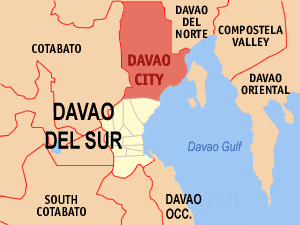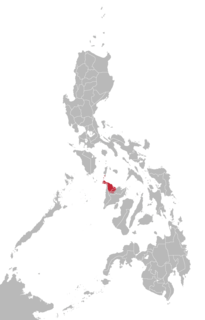Related Research Articles

Davao City, officially the City of Davao, is a 1st class highly urbanized city in the island of Mindanao, Philippines. The city has a total land area of 2,443.61 km2 (943.48 sq mi), making it the largest city in the Philippines in terms of land area. It is the third-most populous city in the Philippines after Quezon City and Manila, and the most populous in Mindanao. As of the 2015 census the city had a population of 1,632,991.

The Bisayan languages or the Visayan languages are a subgroup of the Austronesian languages spoken in the Philippines. They are most closely related to Tagalog and the Bikol languages, all of which are part of the Central Philippine languages. Most Bisayan languages are spoken in the whole Visayas section of the country, but they are also spoken in the southern part of the Bicol Region, islands south of Luzon, such as those that make up Romblon, most of the areas of Mindanao and the province of Sulu located southwest of Mindanao. Some residents of Metro Manila also speak one of the Bisayan languages.
The Central Philippine languages are the most geographically widespread demonstrated group of languages in the Philippines, being spoken in southern Luzon, Visayas, Mindanao, and Sulu. They are also the most populous, including Tagalog, Bikol, and the major Visayan languages Cebuano, Hiligaynon, Waray, Kinaray-a, and Tausug, with some forty languages altogether.

The Philippine languages are a proposed group by R. David Paul Zorc (1986) and Robert Blust that include all the languages of the Philippines and northern Sulawesi—except Sama–Bajaw and a few languages of Palawan—form a subfamily of Austronesian languages. Although the Philippines is near the center of Austronesian expansion from Formosa, there is little linguistic diversity among the approximately 150 Philippine languages, suggesting that earlier diversity has been erased by the spread of the ancestor of the modern Philippine languages.

The Lumad are a group of Austronesian indigenous people in the southern Philippines. It is a Cebuano term meaning "native" or "indigenous". The term is short for Katawhang Lumad, the autonym officially adopted by the delegates of the Lumad Mindanao Peoples Federation (LMPF) founding assembly on 26 June 1986 at the Guadalupe Formation Center, Balindog, Kidapawan, Cotabato, Philippines. It is the self-ascription and collective identity of the indigenous peoples of Mindanao.

Aklanon (Akeanon), also known as Aklan, is an Austronesian language of the Bisayan subgroup spoken by the Aklanon people in the province of Aklan on the island of Panay in the Philippines. Its unique feature among other Bisayan languages is the close-mid back unrounded vowel [ɤ] occurring as part of diphthongs and traditionally written with the letter E such as in the name Akeanon (Aklanon). However, this phoneme is also present in sister Philippine languages, namely Itbayat, Isneg, Manobo, Samal and Sagada.
The Iraya language is a language spoken by Mangyans on the island of Mindoro in the Philippines. Zorc (1974) places the Iraya language within the North Mangyan group of Malayo-Polynesian languages, though Lobel (2013) notes that it shows "considerable differences" to Tadyawan and Alangan, the other languages in this group. There are 6,000 to 8,000 Iraya speakers, and that number is growing. The language status of Iraya is developing, meaning that this language is being put to use in a strong and healthy manner by its speakers, and it also has its own writing system.

The Ibaloi language belongs to the Malayo-Polynesian branch of the Austronesian languages family. It is closely related to the Pangasinan language, spoken primarily in the provinces of Pangasinan and Tarlac.

The South Mindanao or Bilic languages are a group of related languages spoken by the Bagobo, B'laan, T'boli, and Tiruray peoples of the southern coast of Mindanao Island in the Philippines. They are not part of the Mindanao language family that covers much of the island. The languages are:
The Greater Central Philippine languages are a proposed subgroup of the Austronesian language family. They are spoken in the central and southern parts of the Philippines, and in northern Sulawesi. This subgroup was first proposed by Robert Blust (1991) based on lexical and phonological evidence, and is accepted by most specialists in the field.
Blaan is an Austronesian language of the southern Philippines, similar to Tboli.
Davaoeño (Dabawenyo) is a language of the Davao Region of Mindanao in the Philippines. According to Zorc (1977), it is a native Mansakan language influenced by Cebuano and Tagalog. Traditionally, it was the principal language of the Davaoeño people, but it is no longer spoken in Davao City as speakers have shifted to a local dialect of the Cebuano language, called Davaoeño Cebuano.
Mandaya is an Austronesian language of Mindanao in the Philippines. It may be intelligible with Mansaka.
The Negrito peoples of the Philippines speak various Philippine languages. They have more in common with neighboring languages than with each other, and are listed here merely as an aid to identification.

Tagabawa is a Manobo language of Davao City and Mount Apo in Mindanao, the Philippines. Tagabawa is spoken in Cotabato and Davao del Sur provinces, and on the slopes of Mount Apo west of Davao City (Ethnologue). The language is notably spoken by the Bagobo Tagabawa people who have a culture of high respect towards Philippine eagles, known in their language as banog.
The Proto-Philippine language is a reconstructed ancestral proto-language of the Philippine languages, a proposed subgroup of the Austronesian languages which includes all languages within the Philippines as well as those within the northern portions of Sulawesi in Indonesia. Proto-Philippine is not directly attested to in any written work, but linguistic reconstruction by the comparative method has found regular similarities among languages that cannot be explained by coincidence or word-borrowing.
Ati (Inati) is an Austronesian language of the island of Panay in the Philippines. The variety spoken in northern Panay is also called Sogodnin. The Ati people also speak Kinaray-a and Hiligaynon.

Ilocano is an Austronesian language spoken in the Philippines. It is the third most-spoken native language in the country.
The Bagobo language can refer to either of the following Austronesian languages spoken in Mindanao, Philippines:
The Southern Cordilleran languages are a group of closely related languages within the Northern Luzon subgroup of the Austronesian language family. They are spoken in an area stretching from the southern shore of the Lingayen Gulf to the highlands of Quirino province. The most widely spoken Southern Cordilleran language is Pangasinan, one of the eight major languages of the Philippines.
References
- ↑ Giangan at Ethnologue (18th ed., 2015)
- ↑ Hammarström, Harald; Forkel, Robert; Haspelmath, Martin, eds. (2017). "Giangan". Glottolog 3.0 . Jena, Germany: Max Planck Institute for the Science of Human History.
- ↑ Zorc, R. David (2019). "Klata/Giangan: A New Southern Philippine Subgroup" (PDF). The Archive: Special Publication. 16: 33–51.
- 1 2 "Davao City: Facts and Statistics". Davao: History, Culture, Politics, Economy and Progress. August 29, 2015. Archived from the original on April 29, 2016.
- ↑ "10 Tribes of Davao City – Clata part (4–10)". Davao Delights. August 22, 2012. Retrieved April 22, 2018.
- ↑ Bravo, Neilwin Joseph L. (September 19, 2018). "TRMH holds EECOP Medical Mission 2018". Edge Davao.
- ↑ Perez, Ace June Rell S. (September 5, 2017). "In Search of the Last Bagobo Klata Weaver". SunStar Philippines. Retrieved July 28, 2020.